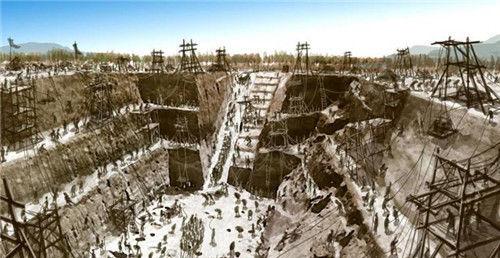Why has the Mausoleum of the First Qin Emperor not been excavated so far? After The German experts scanned with MRI, there was indeed a big discovery
Li Shan drove the Blood Yin Whip, and the hegemony steamed and worried about the Nine Springs. There are no Hidden Daggers under the tomb, so why should there be three thousand terracotta warriors. ——" Guan Qin Terracotta Warriors Miscellaneous Feelings"
Ancient Egypt had the world's largest above-ground king mausoleum, and the world's largest underground mausoleum was in China. That is the Mausoleum of the First Qin Emperor. This is the mausoleum of the first emperor in Chinese history and the first world cultural heritage site in China. It was built in the first year of the reign of the King of Qin (247 BC) and has been built since its inception before it swept Liuhe.
Minister Li Si was the designer, and General Zhang Handan was the overseer. A total of 720,000 people were recruited to build it, eight times more than the number of people who built the Pyramid of Khufu, and it was not until the second year of Qin II (208 BC) that the tomb was built. Lasting a total of 39 years, it is the first well-designed and large-scale imperial tomb in Chinese history.

In March 1974, in Lintong County, Shaanxi Province, a farmer was preparing to dig a well to dig up water to drink. As I fought, I dug up fragments of ancient clay figurines, crossbow machines, and so on. The treasure buried underneath for thousands of years has been presented, and the Terracotta Pit is known as the "Eighth Wonder of the World".
Based on this, the place where the mausoleum of Qin Shi Huang was located was detected. According to the latest records, the total area of the Qinling Underground Palace is about 41,600 square meters, which is as large as five international football stadiums. A large number of cultural relics and treasures are buried inside, which have high historical value and research value.
However, since 1974, except for a few terracotta warrior tunnels, they have been carefully excavated. The rest of the main part has not been excavated, and it is still well protected. And there's a reason for that. In Sima Qian's "Records of the First Emperor", there is a record of the Tomb of the First Emperor:
Wear three springs, go down to the copper and cause the rafters, the palace view of the hundred officials and strange instruments rare and strange migration Zang Manzhi, so that the craftsman to make a crossbow arrow, some through the close to shoot it. With mercury as a hundred rivers and seas, organic phase instilling, astronomy on the top, geography on the bottom, mermaid paste as a candle, the degree of immortality for a long time.
First of all, "wearing the three springs" represents the depth of the underground palace, which is already too deep to be deep. According to the data, the thickness of the soil covered by the Shi Huang Mausoleum led to the cost of excavating its earthworks as high as 60 billion yuan, equivalent to one-fifth of Handan's GDP, and if you want to excavate the Mausoleum of the First Emperor of Qin, you must first pay such a high price.
And the next "Rare Migration Zang Manzhi", which represents the number of objects and treasures in the Shi Huang Mausoleum can not be underestimated. But this is even more impossible to excavate, because archaeologists have been taught a lesson when excavating the Terracotta Pit. The original terracotta warriors were brightly colored, but they were not well protected at the time of mining.
As soon as these terracotta warriors came into contact with the air, they quickly edified in an instant and became today's colorless terracotta figurines. With such a lesson, not touching the Qinling Underground Palace before making preparations has become a tacit thing for archaeologists. There are also organs and other things mentioned later, which also mean that there will be no good fruit to eat if you rush into the mausoleum.
The mountains, rivers and seas of mercury watering in the Tomb of the First Emperor have been scanned by German experts with nuclear magnetism, and the sealing soil of the Lishan Tomb has been tested. The results are all big discoveries, and there is a thermal anomaly inside the Qin Tomb, which means that the internal anti-theft organs are still operating.
The monitoring of the sealed soil shows that the mercury exceeds the standard, that is, the mercury in the Tomb of the First Emperor is likely to be true. Let's not talk about the organs, let's talk about mercury. Mercury is a highly toxic substance, which volatilizes toxic gases at 0 °C, and the higher the temperature, the faster it volatilizes.
And an area as large as the First Emperor's Mausoleum is all mercury. If the hasty excavation causes mercury to volatilize, what kind of consequences will it bring to the surrounding area? The purpose of not excavating the Shi Huang Mausoleum is not only this, according to the regulations of the State Administration of Cultural Heritage, never take the initiative to excavate the mausoleum.
Most of the current archaeological work is rescue excavations, only to protect cultural relics. After the 20th century, the concept of trying not to take the initiative to excavate the mausoleum has become the consensus of the international archaeological community. Let Qin Shi Huang and his palace soldiers continue to sleep peacefully. It is the respect of the living for the deceased, and it is also the safest and most appropriate way to protect cultural relics.